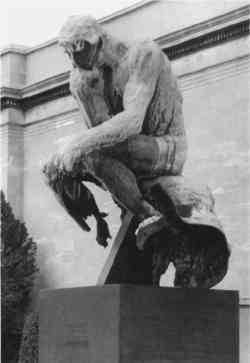TWENTY-FIVE YEARS AFTER THE BOMB: MAINTAINING CLEVELAND'S THE THINKERBRUCE CHRISTMAN
4 TREATMENT SINCE 1980In 1980, the museum began a program to maintain all of its outdoor sculptures—including The Thinker—on a more regular basis (fig. 5). The previous treatments of oil had left a fairly thick film, which had trapped a great deal of dirt, in the protected and lower areas of The Thinker. In order for any treatment to be successful, it was imperative to remove the oil.
The Thinker was first washed with Orvus anionic detergent and water. This successfully removed much of the dirt but not much of the oil. Acetone and cotton swabs were used to remove the oil. The application of acetone was repeated several times until there was no evidence of oil coming up in the cotton. Two thin brush coats of Incralac were applied followed by two spray coats. The Thinker was then given a final layer of wax. The Thinker now receives routine maintenance twice a year, in the spring and fall. It is washed with Orvus soap and rewaxed with either MinWax or Butcher's Bowling Alley Paste Wax. Any breaks in the lacquer are touched up. At the time The Thinker was treated with Incralac many conservators were using this product as a protective layer. It was felt that the acrylic coating would provide better protection for the sculpture in an outdoor environment. To date, the Incralac coating on The Thinker has not degraded enough to require its removal from the surface. Based on experience with several of the other sculptures in the museum collection, the removal of the Incralac is a slow process. Because of this difficulty in removal, the continued use of Incralac on The Thinker will need further study. More extensive treatment, such as aesthetic reintegration of the patina on The Thinker, was not done as the sculpture has been so radically altered by the bombing. So much of Rodin's artistic intent was altered by the bombing that the corroded surface is a relatively minor issue. This sculpture has taken on a life of its own–part Thinker by Rodin, part history, part social statement. A unique and haunting beauty has emerged. The museum's philosophy is to stabilize the sculpture in its present condition. Recent detailed examination of The Thinker indicates that there may be additional damage from the explosion. Deep pits are present on the legs and other lower surfaces. These pits are located within “sight line” of where the dynamite was positioned. They have ragged edges and seem to erupt from the surface, suggesting they may have been formed from the percussion of the explosion. Essentially, the pits are incipient tears and cracks in the metal. At the center of many of the pits are areas of light green corrosion, which may be caused by chemical residues left from the dynamite as it is not seen Another problem is the presence of wildlife inside the sculpture. Because the bottom of the sculpture is now open to the elements, birds found it is a great place to nest. The nests have now been pulled out, and nylon screening coated with tinted Incralac has been worked up inside of the legs and the figure to deter future inhabitation. |
